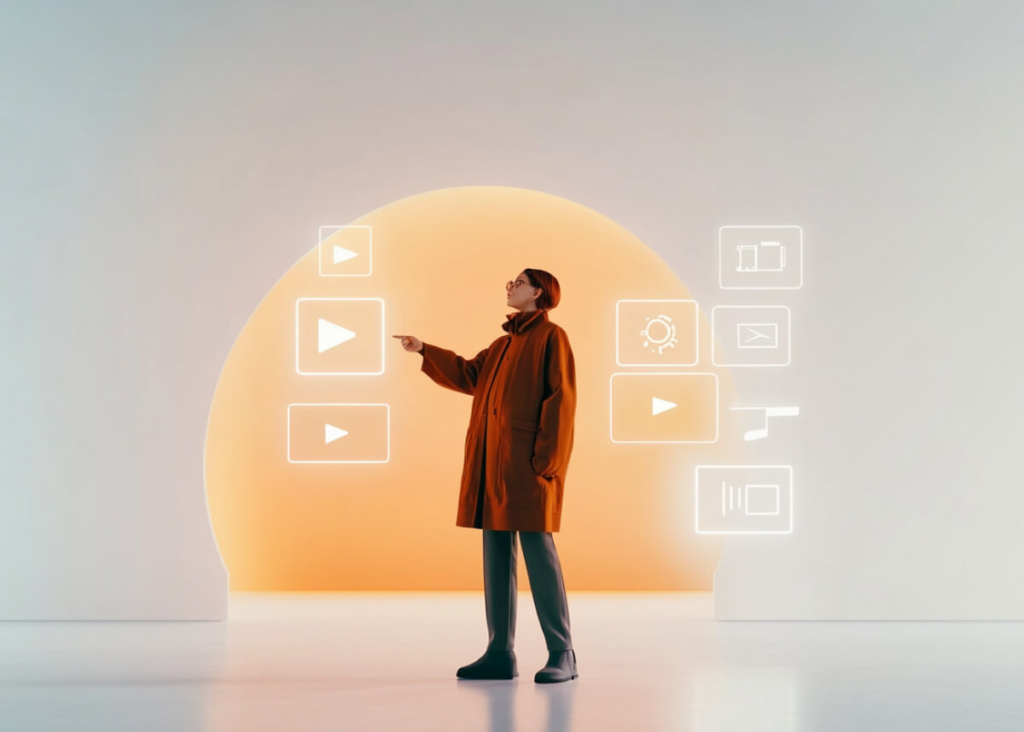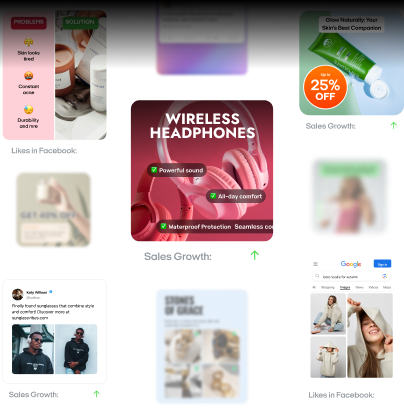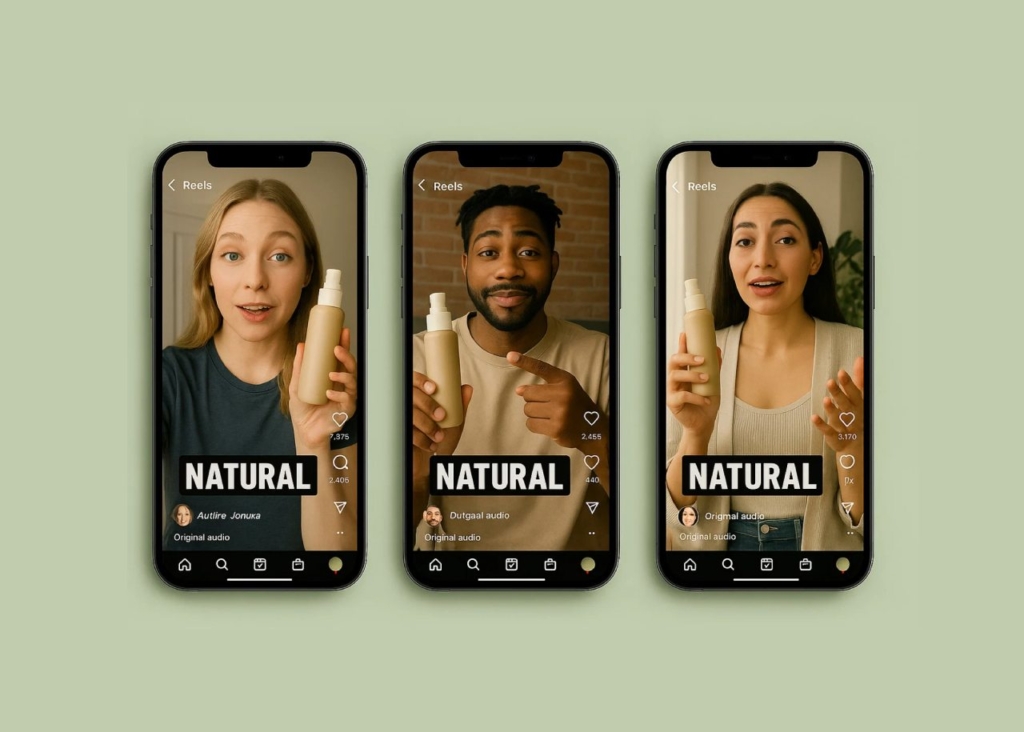Mastering AI marketing campaigns: 4 key trends and useful strategies
Ever launched a marketing campaign that didn’t quite hit the mark? In fact, 95% of marketers believe their budget could go further with better automation.
That’s where AI comes in — replacing manual work with smart automation and turning guesswork into data-driven decisions.
Also known as algorithmic marketing, it uses machine learning and predictive analytics to help you create more targeted, high-converting campaigns.

Why AI marketing matters
By 2030, the AI-powered marketing industry is projected to reach $1.81 trillion, and for good reason. AI isn’t just a trend, it’s transforming how brands connect with audiences, optimize campaigns, and improve conversions.
Unlike traditional marketing, which often relies on assumptions, AI analyzes real-time customer data to personalize content, optimize ad placements, and predict trends before competitors do. This shift has already changed the industry — 88% of marketers say they use AI daily, and businesses leveraging AI-generated headlines see up to 59% higher click-through rates.
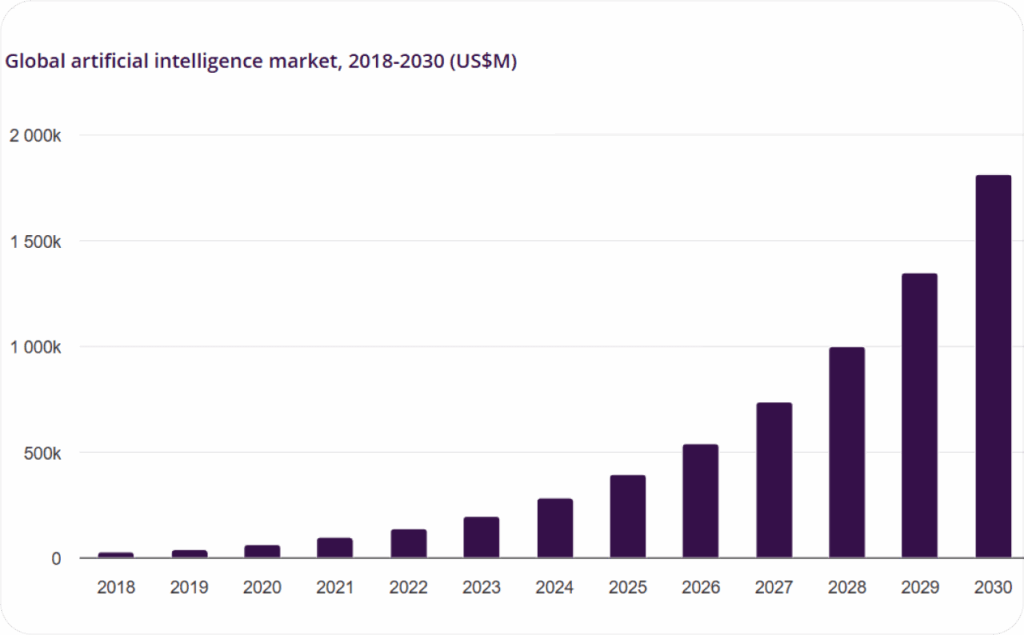
How AI marketing works
AI marketing automates and enhances marketing tasks by identifying patterns in customer behavior, like browsing habits, purchase history, and content engagement. Instead of manually testing different strategies, AI dynamically adjusts campaigns based on what’s working.
For example, AI tools can personalize ads for different audiences, suggest the best time to launch a campaign, and refine messaging in real time. These optimizations not only increase engagement but also make marketing more cost-effective and scalable.
How AI has transformed marketing
In the past, marketers relied on spreadsheets and manual reporting, making it difficult to track fast-changing consumer behavior. Early automation — like email segmentation — helped, but it barely scratched the surface of personalization.
Today, AI marketing platforms use deep learning and real-time data processing to fine-tune campaigns as they run. They can test thousands of ad variations simultaneously, track user engagement instantly, and adjust budgets automatically. Instead of waiting weeks for insights, marketers now get immediate feedback, allowing them to make informed decisions before losing momentum.
This agility is a game-changer. A single missed trend can mean lost revenue, which is why 68% of businesses report higher marketing ROI after adopting AI. Meanwhile, 37% of marketing professionals are already exploring AI-generated content to streamline creative production.
Key differences between AI and traditional marketing
AI marketing still shares a fundamental goal with traditional methods. It is connecting with consumers. However, it sets itself apart in speed, scalability, and precision, as shown in this table:
| Aspect | AI marketing | Traditional marketing |
| Personalization | Real-time micro-segmentation, often using chatbots or conversational AI | Broader segmentation based on demographics |
| Data analysis | Ongoing and predictive, adapts mid-campaign | Mostly historical data, often analyzed post-campaign |
| Optimization cycle | Instant shifts, ad copy, budget, or targeting can pivot the moment data suggests | Periodic updates, monthly or quarterly |
| Scalability | Handles large datasets seamlessly, thousands of creative variations with minimal human oversight | Limited by manual processes and team bandwidth |
| ROI tracking | Real-time feedback loops that show what’s working almost immediately | Typically relies on post-campaign measurement |
| Tools and technology | Specialized AI platforms, machine learning resources, and analytics pipelines | Standard software suites with fewer automation features |
| Marketing focus | Predict-and-act approach that constantly learns from each user interaction | Plan-and-wait strategy guided by broader assumptions |
Understanding these differences is essential because today’s customers demand quick, relevant interactions. AI marketing meets that need by delivering personalization and instant optimization that manual methods can’t match.
Marketing budgets are tighter than ever, and AI marketing ensures each dollar goes further. Rather than sifting through last month’s data, your campaigns pivot on the spot based on up-to-date user behaviors. This continuous refinement speeds up decision-making, cuts waste, and highlights your best-performing tactics faster.
Key AI technologies in marketing
Tired of marketing that relies on guesswork? AI-driven solutions like machine learning for ads, predictive analytics, natural language processing, chatbots, and recommendation engines are reshaping how brands connect with their audiences. These tools analyze real user data, detect emerging trends, and predict consumer behavior, so you could make every campaign smarter and more effective.
Machine learning: The engine of predictive marketing
Machine learning powers predictive modeling, helping marketers move beyond intuition to data-backed decision-making. Instead of relying on static rules, ML algorithms analyze large datasets to uncover patterns, automate ad bidding, and refine customer targeting.
This technology plays a crucial role in optimizing ad spend. By reviewing purchase history and browsing habits, ML can identify the best times to launch ads and the right products to promote. Amazon has successfully applied this strategy, increasing conversion rates by up to 25% by focusing on real customer behavior rather than assumptions.
Predictive analytics: Forecasting customer behavior
A natural extension of ML, predictive analytics helps marketers anticipate customer behavior, forecast sales trends, and determine customer lifetime value. With AI crunching historical data, brands can identify high-intent audiences, personalize outreach, and adjust strategies in real time. Instead of reacting to trends, predictive analytics puts marketers in a position to shape them.
NLP: Crafting messaging that resonates
Natural language processing allows AI to understand, analyze, and generate human language, making it an essential tool for sentiment analysis, chatbots, and AI ad creation. By assessing customer conversations, NLP-powered tools like ChatGPT and IBM Watson can reveal how people feel about your brand and products.
This insight helps refine messaging, ensuring your content resonates with the audience’s mood and expectations. The result? Higher engagement, stronger loyalty, and reduced ad spend waste — since your messaging is aligned with real consumer sentiment.
Chatbots: Your 24/7 brand representatives
AI-driven chatbots go far beyond scripted responses. Using NLP and ML, they engage customers in real-time, offering instant support, personalized recommendations, and seamless shopping experiences.
Brands that implement AI-powered chatbots have seen up to a 67% increase in sales. These digital assistants handle common questions, freeing up human teams for complex issues while keeping customers engaged around the clock. Whether answering FAQs or guiding a customer through a purchase, chatbots enhance both customer experience and revenue potential.
Recommendation engines: Driving personalization and revenue
AI-powered recommendation engines analyze user data, like clicks, session duration, past purchases, etc. They then deliver highly relevant suggestions. Platforms like Netflix and Amazon rely on these engines to increase engagement, and businesses that implement personalization strategies see revenue growth of 5% to 15%.
Integrating recommendation engines into marketing campaigns boosts conversion rates by making product suggestions feel natural and intuitive. Pairing this technology with marketing automation creates a seamless customer journey, where every interaction feels uniquely tailored.

Why an integrated AI approach delivers better ROI
AI works best when technologies are combined. Machine learning, predictive analytics, NLP, chatbots, and recommendation engines each solve different marketing challenges, but together, they create a data-driven system that continuously refines and optimizes itself.
Starbucks uses ML to enhance customer loyalty programs. JPMorgan Chase saw a 450% increase in ad engagement by letting AI refine its messaging. These success stories highlight how AI doesn’t just make marketing smarter, it makes it more profitable.
By integrating these technologies into a single strategy, brands move from reactive marketing to proactive growth. Whether you’re a startup or an enterprise, AI-powered insights eliminate guesswork, refine engagement, and keep you ahead of the competition.
Key AI tools in marketing
Finding the best AI marketing platforms in 2025 can feel like a maze. With so many options promising to optimize ads, deliver actionable analytics, and generate on-brand content, it’s critical to understand which solution aligns best with your goals, budget, and technical expertise.
Below, you’ll find an overview of Google Marketing Platform, Salesforce Marketing Cloud, Adobe Experience Cloud, HubSpot Marketing Hub, and Zeely AI, along with a snapshot of how these tools differ in scope, pricing, and real-world impact.
What’s Zeely AI?
Ideal for small businesses and early-stage brands, Zeely AI simplifies ad creation and content production by providing AI-generated static ads and videos. Its goal is to help clients launch effective Facebook or Instagram ads without requiring deep technical expertise.
Some entrepreneurs report saving up to 97% of their time when creating and launching ads, thanks to Zeely’s streamlined campaign management. Plans range from $29.95 to $79.95 per month, each offering varying credits for static creatives, AI videos, and ad campaigns. Compared to more enterprise-focused platforms like Adobe, Zeely AI prioritizes speed, simplicity and affordability above all else.
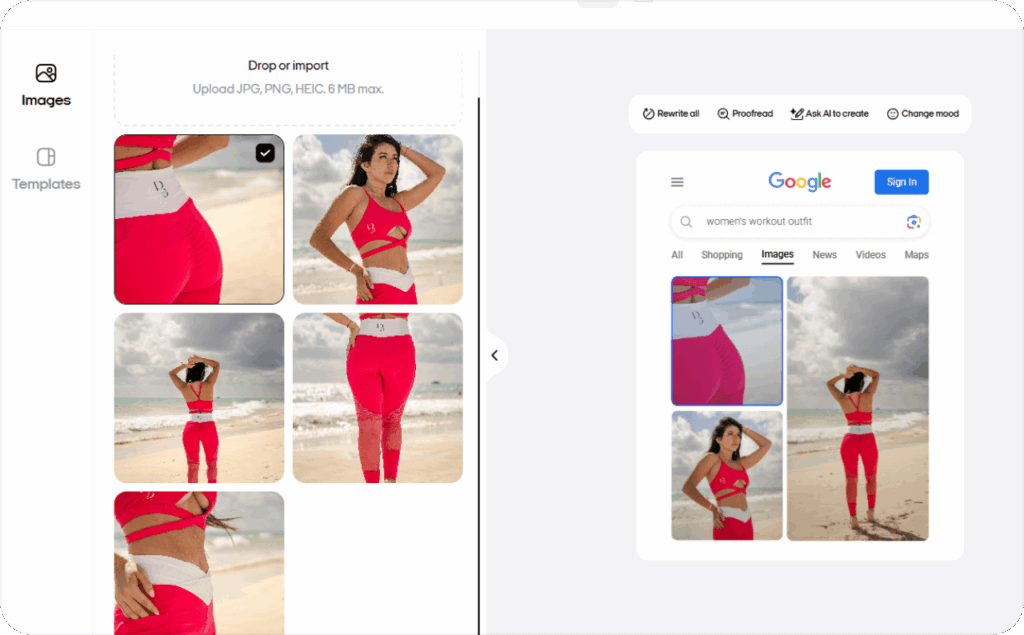
What’s Google Marketing Platform?
Google Marketing Platform is a comprehensive, AI-powered suite that integrates Google Ads, Display & Video 360, and Google Analytics under one roof. By combining real-time insights, smart bidding, and predictive metrics, GMP empowers mid-size to enterprise brands to make data-driven decisions across multiple channels.
Many e-commerce giants, including Adidas and Sephora, have seen up to a 30% ROI boost through dynamic ad personalization and predictive conversion analysis. If you invest more than $100K in monthly ad spend, GMP’s machine learning-based features can unify your workflow and significantly improve ad performance.
GMP is frequently mentioned on the “Best AI marketing platforms 2025” lists for its focus on real-time optimization rather than deep CRM functionality, which sets it apart from Salesforce Marketing Cloud.
What’s Salesforce Marketing Cloud?
Built on Einstein AI, Salesforce Marketing Cloud offers AI-driven marketing automation, advanced lead scoring, and nuanced segmentation. It’s often the top choice for mid-to-large enterprises already leveraging Salesforce CRM to personalize campaigns across email, mobile, social, and web.
By harnessing Salesforce’s Einstein 1 Platform, some sales teams report saving 3.5 hours per day, with customer satisfaction rising by 52%. When you need full-funnel visibility, especially for complex B2B marketing, Salesforce bridges marketing and sales pipelines better than most alternatives.
Premium tiers can run into thousands of dollars per month, but for teams with sufficient resources, Einstein’s predictive analytics can be a game-changer.
What’s Adobe Experience Cloud?
Adobe Experience Cloud relies on Adobe Sensei AI for detailed analytics, automated A/B testing, and creative personalization. It brings together Adobe Analytics, Adobe Target, and Adobe Campaign, offering a unified system for orchestrating multi-channel campaigns.
Retailers report up to a 25% lift in average order value by leveraging Sensei’s recommendation engine for personalized product suggestions. However, this enterprise-level solution can be pricey. Unless you’re already invested in Adobe’s ecosystem, or have the budget to match, you may find more affordable alternatives for smaller-scale marketing.
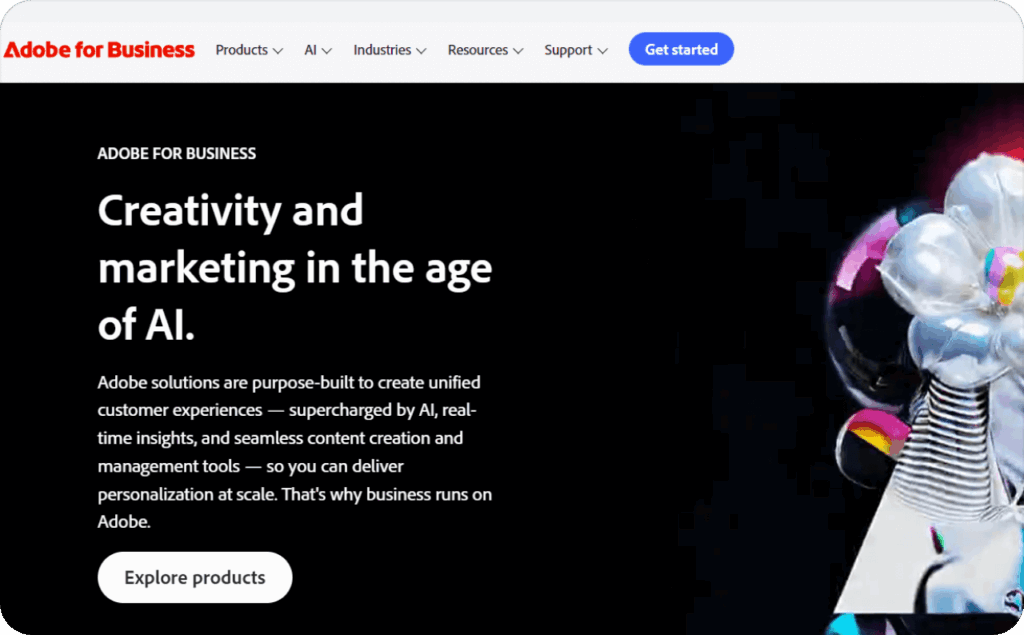
What’s HubSpot Marketing Hub?
HubSpot Marketing Hub is designed for small-to-mid-sized teams, delivering AI-driven automation, email deliverability, lead scoring, and content optimization. Its integrated CRM and marketing modules reduce the complexity you’d find in more enterprise-heavy suites like Salesforce.
Many SMBs have seen email open rates climb by 21% after adopting HubSpot’s AI-based send-time optimization. If you’re seeking an all-in-one approach without the steeper learning curve of a fully enterprise-grade platform, HubSpot is a strong contender. It also connects seamlessly with specialized tools like Jasper.ai and Persado for more advanced AI copywriting and content personalization.
Choosing the right AI marketing tool
Your ideal AI marketing tool hinges on your objectives. For predictive lead scoring and multichannel automation, Salesforce or Google Marketing Platform might stand out. If you want creative personalization or already rely on Adobe Creative Cloud, Adobe Experience Cloud could be the best fit.
Those seeking an all-in-one automation suite with an easier learning curve may prefer HubSpot. And if you’re running a lean operation focused on quick, affordable ad launches, Zeely AI is worth exploring.
Key AI trends in marketing
Now that we’ve covered the AI marketing tools boosting campaign performance, it’s time to look at the bigger picture.
These tools don’t just solve immediate needs, they’re driving powerful trends. Understanding these shifts will help you stay ahead of the curve and build an agile, data-backed strategy for the future.
Hyper-personalization at scale
AI helps you deliver tailored messages and product recommendations in real time — no guesswork required. Tools like Dynamic Yield and Adobe Target instantly adapt website content to each visitor’s preferences, creating a frictionless user experience. It’s a strategy that leaders like Netflix and Amazon use to maintain high engagement.
By following their lead, you can increase conversions, optimize marketing spend, and establish a clear competitive advantage. Plus, personalized interactions build stronger relationships and foster the loyalty that drives long-term growth.
AI-generated content and creative automation
Generative AI offers solutions like ChatGPT and Jasper. They help produce first drafts of blog posts, social captions, and product descriptions in seconds. Synthesia and Runway ML specialize in on-demand visuals and videos.
A 2024 HubSpot study found that brands using AI-assisted content workflows deliver projects faster and cut costs easier, all while maintaining a consistent brand voice. Zeely AI focuses on ad creatives, UGC-style video creation, and ad campaigns, allowing small businesses to have an all-in-one platform to create and set up ads without an expanded team or big budget.
Automated customer engagement
AI-powered chatbots and virtual assistants provide round-the-clock, personalized support on websites, messaging apps, and voice interfaces. They handle repetitive tasks, like account checks or basic product recommendations, so your human team can tackle more complex issues.
Bank of America’s virtual assistant, Erica, has managed over a billion interactions, proving that AI can handle large volumes of queries seamlessly. This “always-on” engagement cuts response times, reduces support costs, and boosts loyalty. When integrated with CRM data, AI can also personalize suggestions based on each user’s profile.
Predictive targeting and AI-optimized advertising
Machine learning takes the guesswork out of audience targeting. Meta’s Advantage+ and Google’s Performance Max analyze real-time data to refine placements, bids, and audience segments.
A 2024 McKinsey report shows that brands embracing AI-driven predictive targeting see improvements. Businesses report up to a 30% lift in ROAS and a 20% increase in engagement rates compared to traditional methods.
With third-party cookies on the decline, first-party data teamed with AI ensures privacy-friendly targeting that remains highly effective. Expect fewer wasted ad dollars, more conversions, and a data-backed approach to outreach.
Strategies for implementing AI in marketing campaigns
We’ve discussed the technologies, tools, and emerging trends that are shaping AI in marketing. Now it’s time to translate those insights into action.
This seven-step guide covers goal setting, team building, data preparation, and more—ensuring your business stays agile, data-driven, and poised for long-term success.
Step 1: Define clear objectives
Implementing AI marketing begins with specific, measurable goals. Perhaps you want to boost email open rates by 10% or cut cost per acquisition by 20%?
Use SMART criteria, meaning Specific, Measurable, Achievable, Relevant, Time-bound, so everyone, from marketing leads to data analysts, understands what success looks like. Clear objectives unify your team and make AI campaign optimization more straightforward.
Step 2: Build the team
Even powerful AI tools need skilled people behind them. If you’re a smaller company, designate one team member to learn basic AI skills on Coursera, DataCamp, or HubSpot Academy.
Larger firms often form cross-functional groups, blending marketing strategists, data engineers, and IT support. Whether you pick turnkey AI solutions or develop them in-house, a trained, diverse team is vital for data-driven decisions.
Step 3: Prepare your data
Your machine learning models thrive on accurate, privacy-safe data. Gather or merge CRM records, website analytics, and social data. If you spot gaps or outdated info, consult data engineers to fix and unify these sources.
Don’t overlook GDPR or CCPA obligations — these laws protect customers and build trust. Strong data sets the stage for reliable personalization algorithms that adapt to real-time consumer behaviors.
Step 4: Select AI tools
Compare tools based on cost, scalability, and integration features. Salesforce Einstein or Adobe Sensei help large teams manage multi-channel operations, while Zeely AI fits smaller businesses with simpler needs.
Watch for bias detection and transparent data handling to uphold ethical AI. Consider how well each platform handles real-time analytics so you can respond quickly to shifting consumer trends.
Step 5: Pilot AI initiatives
Launch a 2-4 week pilot in one channel, like email campaigns or product recommendations, to test the waters. Track CTR, customer acquisition cost, or return on ad spend to see if your pilot meets or exceeds past benchmarks.
If you get a 10-15% improvement in open rates or conversions, it’s a strong green light. Smaller eCommerce shops might start with a simple recommendation engine, while mid-sized retailers might tackle more advanced personalization. Early wins help you refine and iterate without overcommitting resources.
Step 6: Implement AI and grow
When pilot results meet expectations, roll out your AI tools to more channels or departments. For instance, you might add web personalization or an AI assistant for sales. Share notable improvements, like a 20% drop in cost per acquisition, to gain executive support and a larger budget.
Large organizations may invest in comprehensive, multi-feature platforms, while smaller ones can expand at a steady pace, adding each AI-driven feature as resources allow. Stay mindful of ethical AI and user privacy so you preserve customer trust.
Step 7: Monitor and optimize
Ongoing monitoring keeps your AI campaigns aligned with user behavior. Track KPIs like CTR, CAC, and ROI through analytics tools, then schedule regular check-ins, weekly or monthly, to evaluate progress.
Refresh audience segments, adapt creative assets, and retrain machine learning models as consumer preferences shift. Stay aware of potential bias or privacy concerns, and address them immediately. By iterating and measuring success of AI marketing campaigns frequently, you stay agile and competitive.
By following these seven steps, you can implement AI marketing in a way that’s both practical and scalable. Whether you’re a solo entrepreneur testing automated recommendations or a large firm rolling out multi-channel campaigns, success depends on clean data, a competent team, and regular review. Tackle your first pilot, measure results, and let those insights guide your next move toward a fully AI-driven strategy.
Conclusion
AI is no longer an optional add-on for tech-savvy brands, it’s a core strategy that can transform how you reach and engage your audience. From hyper-personalization to predictive targeting, the latest AI tools empower marketers to make fast, data-driven decisions that cut costs and boost ROI.
By focusing on clear objectives, data quality, and collaborative teams, you’ll be ready to run pilots, scale up when you see results, and keep refining your approach as consumer trends shift.
Whether you’re a solo entrepreneur or managing a global enterprise, the playbook is the same: start small, learn quickly, and expand once you’ve proven the value of AI-driven campaigns. This iterative process not only safeguards your budget but also helps your team become more agile and confident.
With AI at the helm, you’ll position your marketing efforts for sustainable, long-term growth in a digital landscape that never stops evolving.
Also recommended
